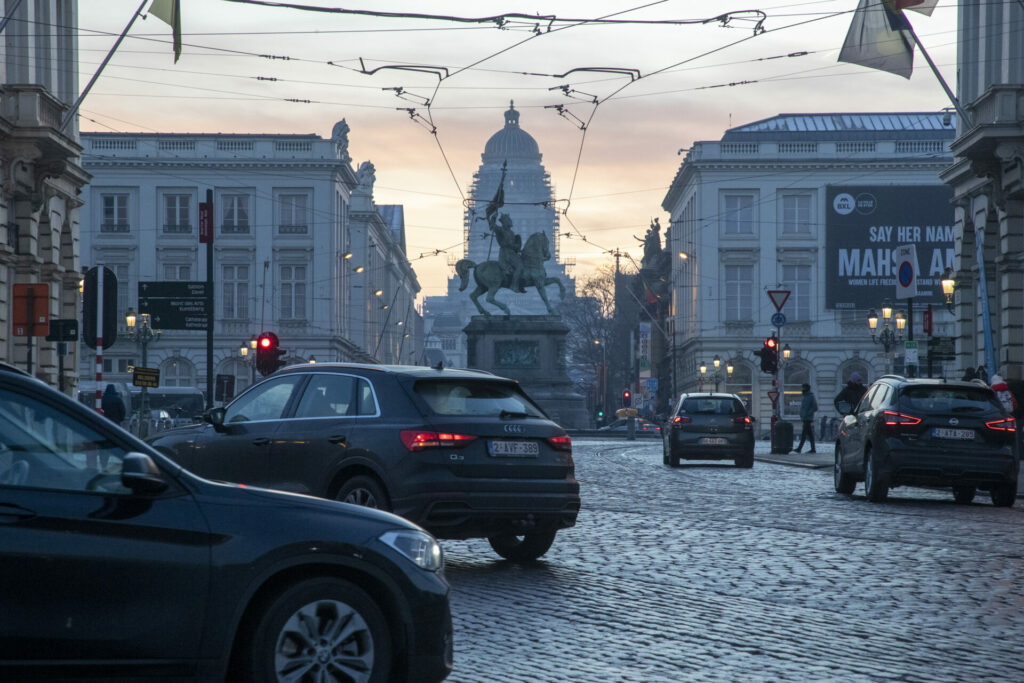New monitoring points installed to measure the concentration of nitrogen dioxide (NO2) are showing worryingly high values of pollution, especially on Brussels' major axes.
Almost two years ago, the results of the largest-ever citizen survey on air quality in the Belgian capital were published. CurieuzenAir saw 3,000 Brussels residents measure NO2 at the end of 2021.
The survey showed that air quality in Brussels improved considerably in recent years, but also highlighted major disparities in each neighbourhood.
The results correlated with socio-economic backgrounds: the city's most disadvantaged and vulnerable households were breathing air of a markedly different quality from wealthy residents.
In the wake of these results, Brussels Environment and some 20 Brussels organisations and companies launched ExpAIR. They hung 24 monitoring points to measure the concentration of NO2 in places where air quality was suspected to be poor and where there was no official measuring station.
 Map showing the additional measuring points. Credit: BRAL
Map showing the additional measuring points. Credit: BRAL
The first interim results for July, August and September have already shown that many places in Brussels fall outside the primary network (where the official monitoring stations are located) where air quality is "illegally poor".
Far above threshold
Air pollution is the biggest environmental health risk in Europe. It causes lung infections, has an effect on cardiovascular disease and increases the risk of cancer. In Belgium alone, air pollution causes about 6,500 premature deaths per year.
Recent improvements, such as Brussels' low-emission zones (LEZs), have helped reduce up to 30% in NO₂ concentrations along the main roads. Meanwhile, the primary network measurements for 2022 indicated that there are no violations of European air quality standards.

Credit: Belga / Benoit Doppagne
However, these local measurements have shown pollution remains high along many other major axes, sometimes with values above 70 µg/m³ of air.
"On those major axes where there is a lot of traffic, the levels were very high, but even in residential areas, they were also very high and we were surprised by that," Eva Forceville, project officer at Bral, which helped install the measuring points, told The Brussels Times.
In residential neighbourhoods near Porte de Flandres in Molenbeek and the Barrière of Saint-Gilles, values above 40 and even 50 µg/m³ were measured.
Related News
- Car-Free Sunday saw 'significant reductions' in air and noise pollution
- A public health victory: Low Emission Zone significantly improves Brussels air quality
The European threshold is 40 µg/m³ of air per year, but the World Health Organisation (WHO) has proposed that the advisory value for healthy air must be brought down to 10 µg/m³ per year. This highlights that pollution levels in Brussels remain much above what they should be.
"Almost nowhere did the ExpAIR network measure values below 10 μg/m3 NO2," Forceville noted. She did stress that the group deliberately measures in the most polluted areas of Brussels, which also partly explains these poor figures, to show policymakers where extra measures are needed.
If the air contains between 10 and 25 µg/m³ of NO2, it is already harmful to vulnerable groups (children and the elderly). Above 25 µg/m³, it is harmful to all people, and even reduced concentrations of air pollution affect different aspects of health more than previously understood.
Forceville stressed that these preliminary results account for just three months whereas the WHO and EU limits concern annual thresholds, but in many places, the thresholds have already been surpassed.
The measurements will continue for at least another year, allowing for comparison with European thresholds.

